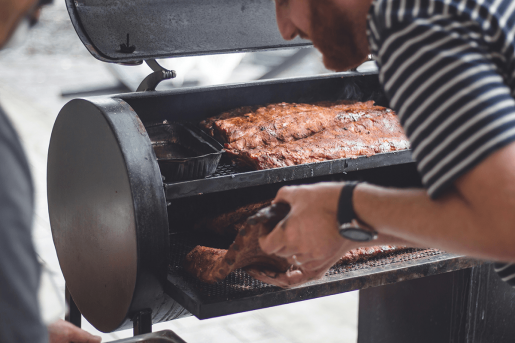Smoke and sizzle: what you need to know about smoked meat

With brisket, sausage and ribs always available, smoked meats are a staple in Texas. A dietitian from Baylor College of Medicine weighs in on the benefits and detriments of these savory goodies.
“While there are potential risks associated with consuming large amounts of smoked meat, this should not deter you from enjoying barbecue in moderation, especially during rodeo season,” said Dr. Luis Rustveld, assistant professor of family and community medicine at Baylor. “The primary concern is the formation of potentially harmful compounds during the smoking process. The more you eat smoked meats, the higher chance you have of facing negative effects.”
Where there is smoke, there are PHAs and HCAs
Food preparation that requires prolonged exposure to smoke and high heat, like smoking, allows for the formation of polycyclic aromatic hydrocarbons (PAHs) and heterocyclic amines (HCAs). These compounds have been linked to an increased risk of cancer, particularly when consumed in large quantities over time. Foods that are prepared through long smoking times or have visible char through direct contact with flames are key indicators that these compounds are in your food.
Smoking food at high temperatures for extended periods can lead to the loss of water-soluble vitamins and minerals, such as vitamin C and certain B vitamins. These nutrients are sensitive to heat and leach out of the food during the smoking process. This preparation method also denatures proteins in the food, altering their structure and potentially affecting their digestibility and bioavailability. While this may not have a significant impact on the overall nutritional value of the food, it can influence how the body absorbs and utilizes protein.
Who might need to skip the smoke
Certain populations should be mindful of the amount of smoked goods they consume or may even need to skip them altogether.
Pregnant women are susceptible to complications if they consume raw or undercooked foods, which may contain harmful bacteria. Foods with high sodium and nitrate content, like those found in smoked meats, can be detrimental to maternal and fetal health if consumed excessively.
Young children have developing immune systems and may be more susceptible to foodborne illnesses associated with smoked meats. Their smaller bodies may also be more sensitive to the high-sodium content found in many smoked products.
Because smoked meats are often high in sodium, patients with cardiovascular issues may experience elevated blood pressure, which can be dangerous. Individuals with heart disease or high blood pressure should limit their intake of smoked meats to help manage their condition. Patients with hypertension should also be aware of their intake as it may lead to elevated blood pressure and fluid retention.
Smoked meats can be high in phosphorus and potassium, which can severely impact those with kidney disease.
Finally, the potential carcinogenic compounds formed during the smoking process can cause complications for individuals with a history of cancer or those at high risk of developing cancer.
Choosing the right smoke
Overall, choosing hardwoods and fruit woods for smoking can help minimize the production of potentially harmful compounds while imparting delicious flavor to your smoked meats and foods. These include woods such as apple, cherry, peach and pear, which are popular choices for smoking due to their mild, sweet flavor. These woods generally produce lighter, cleaner smoke compared to denser woods like hickory or mesquite, resulting in fewer potentially harmful compounds being formed during the smoking process.
When using charcoal for smoking, it’s best to opt for natural lump charcoal or hardwood charcoal without added chemicals or fillers. Avoid briquettes containing additives or lighter fluid, as they can introduce unwanted flavors and potentially harmful compounds into the smoke.
Above all, Rustveld advises avoiding softwoods such as pine, cedar or spruce for smoking, as they contain higher levels of resin and can produce harsh, bitter smoke that may impart undesirable flavors to the food. Additionally, burning softwoods can release potentially harmful compounds into the smoke.
“This rodeo season, allow yourself to enjoy smoked foods in moderation rather than indulging excessively,” Rustveld said. “Choose leaner cuts such as chicken breast, turkey or lean cuts of beef or pork, balance out the rich, smoky flavors of smoked foods with fresh, lighter fruits and vegetables, and take advantage of the atmosphere of rodeo events by participating in fun activities like line dancing, walking around the grounds or even joining in on some of the rodeo-themed games and competitions to burn off extra calories and stay energized.”
By Aaron Nieto




I just got done smoking a 3lb pork shoulder. For 9 hrs.
I use oak in my smoker!